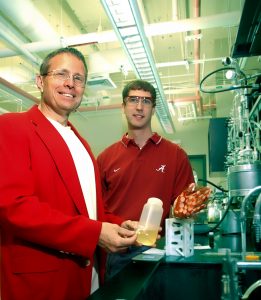 TUSCALOOSA, Ala. – An effort led by a University of Alabama chemist has demonstrated a new way to dissolve and use cellulose – found in the cell walls of trees and other plants – in producing environmentally friendly materials that UA researchers say have potential for the automotive, packaging and textile industries.
TUSCALOOSA, Ala. – An effort led by a University of Alabama chemist has demonstrated a new way to dissolve and use cellulose – found in the cell walls of trees and other plants – in producing environmentally friendly materials that UA researchers say have potential for the automotive, packaging and textile industries.
Dr. Robin Rogers, Distinguished University Research Professor of Chemistry and director of UA’s Center for Green Manufacturing, will be presented the Environmental Protection Agency’s 2005 Presidential Green Chemistry Challenge Award June 20, in recognition of the new technology. Rogers is the nation’s academic winner of the annual award, and he will join with four winners from industry.
“We can make advanced materials where the bulk of the material would be cellulose, and we can do it through a low-energy, solution-processing route,” said Rogers, who is leading the effort which has already led to the awarding of two patents and has four more pending.
A key to the new techniques is the UA researchers’ discovery that a specific solvent, known as 1-butyl-3-methylimidazolium chloride, dissolves cellulose. This liquid is part of a new class of solvents, known as ionic liquids, which, unlike traditional solvents, are typically non-toxic, nonflammable, and do not evaporate, thus significantly reducing harmful emissions, Rogers said.

While cellulose-based plastics have been used on a limited-basis for decades, they are not as popular as petroleum-based plastics, such as polyethylene, which are commonly used in soft drink bottles and milk jugs. In addition to relying on a scarce natural resource that requires dependence on foreign nations, petroleum-based plastics are not biodegradable, and they often accumulate in landfills. “I felt cellulose would be used more, but it didn’t have the right properties,” Rogers said. “It doesn’t have the right toughness, by itself, for a plastic, and you have to find some way to modify it.”
Rogers and the research team have done that. By co-dissolving other materials in the ionic liquid with the cellulose and then restoring the mixture to a solid state, the UA researchers can improve its effectiveness for specific uses.
“We’re dissolving, and/or blending, two or more different polymers and then reconstituting them,” said Rogers, a faculty member in UA’s College of Arts and Sciences. “That allows us to control the physical properties, the hardness, the brittleness, the toughness of the resulting materials.
“Cellulose is used in the plastic industry now,” Rogers said. “Essentially, it is the way it’s being used that we are trying to change. The unique aspect of this project is that we have found an ionic liquid which dissolves cellulose directly without any pre-treatment or without any derivatization.”
The scientists can also alter the form or, as Rogers calls it, the “architecture” of the material, controlling whether or not the material is transformed into a fiber, which could be sewed into cloth, a semi-permeable membrane, or a harder plastic.
In its membrane form, this “designer plastic” can serve as an early warning system to the presence of contaminants. The UA researchers have already demonstrated, through the use of dyes that can change color, its effectiveness as a sensor of small amounts of mercury ions within water, for example.
Contributors to the project, who will be recognized during the June 20 ceremony, include: Drs. Daniel Daly, director of UA’s Alabama Institute for Manufacturing Excellence; John Holbrey, Jonathan Huddleston and Scott Spear, all staff scientists in UA’s Center for Green Manufacturing; Richard Swatloski and Megan Turner, two UA students who recently completed doctorates; Robert Wells, executive director, Alabama Institute for Manufacturing Excellence; and Roy Broughton, a researcher in the Center for Green Manufacturing and department of textile engineering at Auburn University. Undergraduate students who contributed to the project include UA’s Jane Holly Poplin.
UA researchers are testing the robustness of the materials for use in the automotive industry. “The ultimate goal is to license and further develop the technology in a variety of applications,” Rogers said. “Anywhere that you have a plastic application, there may be a use for this type of technology.”
Environmentally friendly discoveries, such as this one, that draw upon something produced by trees and grasses could revitalize the state’s pulp industry, which, in recent years, has closed or scaled back many of its paper operations, Rogers said.
“That’s really where I see this fitting in with our green chemistry strategy.”
EDITOR’S NOTE: Rogers will receive the award in a ceremony at the National Academy of Sciences in Washington, D.C at 5 p.m. (EDT) on June 20.
Contact
Chris Bryant, Assistant Director of Media Relations, 205/348-8323, cbryant@ur.ua.edu
Source
Dr. Robin Rogers, rdrogers@bama.ua.edu